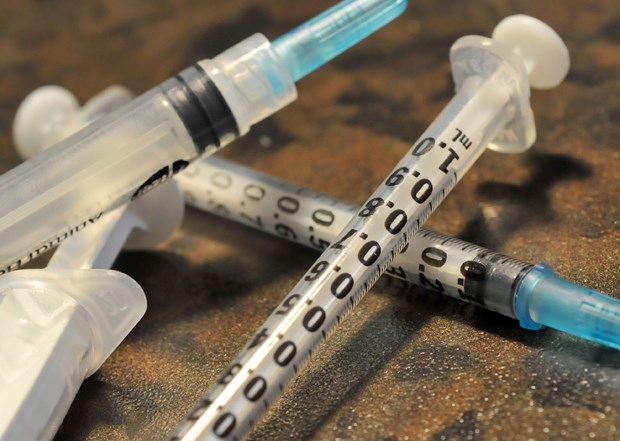Firefighters across the North Shore will receive naloxone kits to carry on their trucks and get training to administer injections as part of efforts to combat the deadly effects of fentanyl in the Lower Mainland.
All three fire departments will be receiving training in October and hope to have the kits on fire trucks by November, said City of North Vancouver Fire Chief Dan Pistilli.
Normally naloxone – a drug that can reverse an opiate overdose – isn’t something firefighters would administer, said Jason Deroy, assistant fire chief with District of North Vancouver Fire and Rescue Services. But the ongoing fentanyl crisis has meant a recent relaxation of the rules about who can obtain and administer the drug.
So far, district crews haven’t had to deal with suspected fentanyl overdoses, Deroy said. But “if we do come across someone who’s suspected of having an overdose, it’s a great thing. It’s a public service.”
That news comes amid continuing concern about overdose deaths linked to fentanyl across the province.
According to recent statistics released by the province, 488 people died of drug overdoses in B.C. between January and the end of August of this year.
A total of 15 people died of drug overdoses in the Coast Garibaldi health region, which includes the North Shore, during that same time period. That’s an increase of 50 per cent over the same time last year, according to the province. As of the end of July, nine of those deaths had been confirmed as being linked to fentanyl, according to the B.C. Coroners Service.
Provincially, 60 per cent of all overdose deaths in 2016 have been linked to fentanyl. In almost all cases, fentanyl was detected along with other drugs, including cocaine, methamphetamine and heroin, according to the coroner.
“That’s been the concern from the beginning,” said Dr. Mark Lysyshyn, medical health officer for the North Shore. People who are dying of fentanyl are “not trying to take fentanyl,” he said, and most of them don’t know it’s in the drugs they are taking. “Almost all the heroin on the street is fentanyl. It’s not heroin.”
It’s also possible some drugs are being cross-contaminated in drug labs, he said.
Despite those concerns, Lysyshyn said the North Shore continues to have a low number of drug overdose deaths – averaging less than 10 per year, in North and West Vancouver combined.
Increasing access to naloxone has been one of the major strategies to combat potentially fatal overdoses, said Lysyshyn.
Naloxone works by plugging into the same brain receptors as opiates, blocking their effects, which can include slowed – and even stopped – breathing. Naloxone is injected into the muscle of a patient’s arm or leg. It has no effect on someone who hasn’t taken opiates, and is considered safe.
Staff in Lions Gate Hospital’s emergency department are now offering patients who are admitted with overdoses take-home naloxone kits, along with instructions for patient and family.
Naloxone kits are also available in North Vancouver at the Health Connection Clinic on 15th Street East and Central Community Health Centre on West Esplanade.
The North Shore Emergency Lookout Society in North Vancouver has had naloxone kits for more than a year and has offered training for staff and clients on its use, said Ken Falconer, community co-ordinator for the North Shore shelter.
Police in North and West Vancouver are also expected to carry naloxone kits – but their kits are primary intended to protect officers in the event of accidental exposure to fentanyl. Lysyshyn said the risk of that would be very low.



